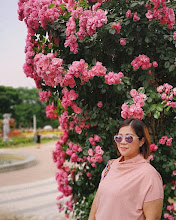Buddha's birthday is one of the most important holidays in South Korea and is celebrated according to the lunar calendar. It usually falls on the eight day of the fourth month of the lunar calendar, and this year, Buddha's birthday is today,
May 3rd.
Last year, Yue and I had the chance to experience the festivities of this important Korean holiday during our first visit to
Bongeunsa Temple. This year, we chose to visit another Buddhist temple in
Seoul - the
Jogyesa Temple, located just a few meters away from Insadong.
 |
| Iljumun - the one pillar gate of the Jogyesa Temple. |
Temple run!
More of Jogyesa Temple after the jump!
The temple was first built in the late 14th century, at the dawn of the Joseon Dynasty. Sometime after, this temple was reduced to ashes after a huge fire and was then rebuilt in 1910 under the name
Gackhwangsa. Some 20 years later, the temple was renamed into
Tegosa, and was assigned as the head temple of Korean Buddhism. And in 1954, after eliminating traces of Japanese influence in the country, Korea revived traditional Buddhism and established the Jogyesa Temple as we see today.
 |
| Gearing up for Buddha's birthday. |
The
Jogye Order is one of the two main sects of Buddhism practiced in South Korea
(the other being the Taego order). The order acts in accordance with the teachings of
Shakyamuni Buddha and its guiding principle is to look directly into the nature of the mind so that one can attain enlightenment and save all beings. The main practice of the Jogye Order is
seon meditation (known in the west as 'zen' meditation) in addition to the reading of sutras, deity practices, and the recitation of mantras.
 |
| Colorful lanterns lined up at the temple's facade. |
They say the best time to visit Jogyesa Temple is on Buddha's birthday or during the Lotus Lantern Festival, when the temple's courtyard is decorated with colorful paper lanterns.
 |
| Lacebark Pine Tree, designated as a Natural Monument in Korea. |
And that was exactly what we saw when we visited Jogyesa Temple on the eve of Buddha's birthday. The 500-year old
Lacebark Pine Tree, which stands in the middle of the courtyard, seemed to grow lanterns instead of leaves.
 |
| Smiling Buddha. |
Meanwhile, this statue of Buddha seemed to be rejoicing at the fact that his followers have put much effort to celebrate his birthday.
 |
| Daeungjeon Hall. |
Daeungjeon Hall, the main dharma hall, has also been dolled up for the celebration, while the monks and the temple staff were busy preparing for the upcoming ceremonies.
 |
| Large statues of Buddha inside the main hall. |
Inside the dharma hall are three large golden statues of Buddha. These three statues represent the
Amitabha Buddha,
Shakyamuni Buddha, and
Bhaisaiya Buddha. The central figure is the
Shakyamuni Buddha who is the founder of Buddhism. On the right, the
Bhaisaiya Buddha represents medicine and is often depicted with a medicinal container. To the left is the
Amitabha Buddha who established a Western Paradise where beings can be reborn to attain enlightenment.
Each of these statues stands over five meters making them the largest indoor statues in Korea.
 |
| Ten-story Buddha Relic Stupa. |
Another structure that stands tall amidst the rows of colorful lanterns is the
Ten-story Buddha Relic Stupa. A relic of Buddha is housed in this structure, which was brought to Korea by a monk who received it from the royal court of Thailand.
 |
| Beomjongru. |
At the far end of the temple, we came across the
Beomjongru, also known as the Brahma Bell Pavilion. This ornate building houses four temple instruments - the Dharma Drum, Cloud Gong, Wooden Fish, and Brahma Bell. The latter is rung 28 times in the morning and 33 times in the evening, which is a sight
(and sound) to behold.
 |
| Large paper doll of Vaisravana, the chief of the Four Heavenly Kings. |
Like Bongeunsa, Jogyesa also offers a
Templestay Program which offers opportunities to learn about Buddhism, These programs are designed to accommodate foreign visitors traveling from abroad and includes activities such as lotus flower making, salt mandala, tea ceremony, and
chamseon (zen meditation).
 |
| Candle offerings. |
To get to
Jogyesa Temple, you can take the following routes:
1.
Jonggak Station (Subway Line 1), Exit 2.
Go 70m forward, then cross the street.
Go 100m more to arrive at a path to Jogyesa Temple.
2.
Anguk Station (Subway Line 3), Exit 6.
Go 50m forward, then cross the street in front of Dongduk Gallery.
Go 50m more to arrive at a path to Jogyesa Temple.
3.
Gwanghwamun Station (Subway Line 5), Exit 2.
Go 150m forward to arrive at a path to Jogyesa Temple between
YTN Parking Tower and Hana Bank.

























5 replies:
Wow! Had no idea! Those paper lanterns look so cool. I bet the light shining through them look so pretty.
Nice relaxing temple a stone's throw away from Insadong. I decided to make a short detour since I was visiting Insadong area. Nice quite corner in the city to visit.
wow so many colors at one place, This place looks so cool and loved your pictures
I can only imagine how awesome it would be to experience the festivities in person. It's so colorful and I'm sure you had a great time celebrating!
I have zero knowledge on Buddhism and their beliefs and it would be nice to learn more. This temple could really help in that. I love how colorful everything is! It's a beautiful celebration.
Post a Comment